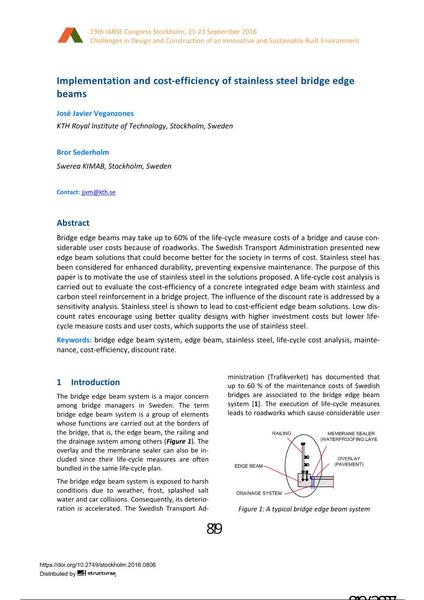Implementation and cost-efficiency of stainless steel bridge edge beams

|
|
|||||||||||
Détails bibliographiques
| Auteur(s): |
José Javier Veganzones Muñoz
(KTH Royal Institute of Technology, Stockholm, Sweden)
Bror Sederholm (Swerea KIMAB, Stockholm, Sweden) |
||||
|---|---|---|---|---|---|
| Médium: | papier de conférence | ||||
| Langue(s): | anglais | ||||
| Conférence: | IABSE Congress: Challenges in Design and Construction of an Innovative and Sustainable Built Environment, Stockholm, Sweden, 21-23 September 2016 | ||||
| Publié dans: | IABSE Congress Stockholm, 2016 | ||||
|
|||||
| Page(s): | 819-826 | ||||
| Nombre total de pages (du PDF): | 8 | ||||
| Année: | 2016 | ||||
| DOI: | 10.2749/stockholm.2016.0806 | ||||
| Abstrait: |
Bridge edge beams may take up to 60% of the life-cycle measure costs of a bridge and cause con- siderable user costs because of roadworks. The Swedish Transport Administration presented new edge beam solutions that could become better for the society in terms of cost. Stainless steel has been considered for enhanced durability, preventing expensive maintenance. The purpose of this paper is to motivate the use of stainless steel in the solutions proposed. A life-cycle cost analysis is carried out to evaluate the cost-efficiency of a concrete integrated edge beam with stainless and carbon steel reinforcement in a bridge project. The influence of the discount rate is addressed by a sensitivity analysis. Stainless steel is shown to lead to cost-efficient edge beam solutions. Low dis- count rates encourage using better quality designs with higher investment costs but lower life- cycle measure costs and user costs, which supports the use of stainless steel. |
||||
| Mots-clé: |
acier inoxydable
|
||||

